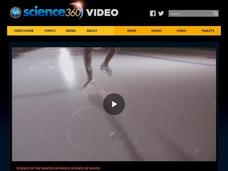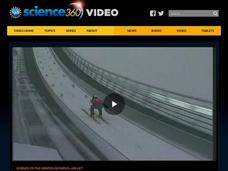National Science Foundation
Engineering the Half Pipe—Science of the Winter Olympic Games
There are no tricks here! Young scholars learn about the concept of centripetal acceleration by studying the design of the snowboarding half pipe. A video lesson describes how the half pipe design affects the motion of the boarders.
National Science Foundation
Slapshot Physics—Science of the Winter Olympics
Take a shot at explaining the physics of hockey! Olympic hockey players explain the science of their craft in a video lesson. The lesson includes a discussion of force and velocity as well as potential and kinetic energy.
National Science Foundation
Olympics Motion—Science of the Winter Olympics
What makes the elite athletes elite? Young scholars watch a thorough video lesson that describes the science of muscle movement. The narrator explores the physical requirements of different sports.
National Science Foundation
Suit Up—Science of the Winter Olympics
You are what you wear! Learn the complex design strategies that result in the competition clothing seen in the Olympics. Scientists consider the requirement of each sport, which typically results in resisting air drag.
National Science Foundation
Mathletes—Science of the Winter Olympics
Investigate the mathematics of the Olympics. A science video how mathematics is important from the basic level of calculating scores to the more complex math of describing the velocity of motion. Scholars learn to view Olympic...
National Science Foundation
Safety Gear—Science of the Winter Olympics
Safety first! A science video explores the design of safety helmets. It considers both elastic and inelastic collisions.
National Science Foundation
Science of Skates—Science of the Winter Olympics
Speed skaters, hockey players, and ice skaters each have skates created specifically for their sports—an interesting fact for your Olympic Games fans! An engaging lesson explores the engineering design of different types of ice...
National Science Foundation
Aerial Physics—Science of the Winter Olympics
Take a leap into the science of motion! An intriguing lesson explains how Newton's third law of motion allows skiers to turn in mid-air. The narrator gives learners skills to practice on their own.
National Science Foundation
Science of Skis—Science of the Winter Olympics
The materials used to produce skis have come a long way over the years. A short video explains how the materials in skis serve a specific purpose on the course. The lesson explores materials such as fiberglass and polymers.
National Science Foundation
Internal Athlete—Science of the Winter Olympics
Cross-country skiers are some of the most disciplined athletes in the world. Young scholars learn about the biology of endurance in an interesting video lesson that highlights athletes of current and past Olympics.
National Science Foundation
Air Lift—Science of the Winter Olympics
Up, up, and away! Young scholars learn how to apply physics to a successful ski jump. An interesting video lesson compares and contrasts drag and lift in the context of a ski jump.
National Science Foundation
Blade Runners—Science of the Winter Olympics
Race to learn the insight of Sir Isaac Newton. A helpful video uses speed skating to explain Newton's laws of motion. Force, acceleration, mass, and momentum all work together to make a successful speed skating race.
National Science Foundation
Snowboarding—Science of the Winter Olympics
The greatest challenge of snowboarding is maintaining balance. An engaging video using a simple demonstration of actual snowboarders to illustrate physics in action.
National Science Foundation
Downhill Science—Science of the Winter Olympics
Newton would have made a first-rate skier! A video lesson analyzes Newton's second law from a skiing perspective. The narrator explains how the force, mass, and acceleration can work together to create a winning run.
National Science Foundation
Banking on Speed—Science of the Winter Olympics
Get on the right track! Young scholars learn about the importance of momentum and friction during a bobsled ride. A video lesson speaks to a bobsled designer to explain how he considers the physics during the design process.
National Science Foundation
Science Friction—Science of the Winter Olympics
Physics plays a role in most sports, and curling is no exception! A video explains how a curling team controls the friction between the stone and the ice to modify its movement.
Be Smart
Should You Eat Every Day?
Many religions and diets suggest fasting, but what does the science say about this method? An interesting video takes on fasting from an evolutionary and scientific perspective as part of a larger biology playlist. It discusses the...
The Brain Scoop
Chicago Adventure, Part Four: Rodents of Unusual Size (And Other Mammals, Too)
The Chicago Field Museum is home to some amazingly large creatures! The installment from a larger mammals playlist takes young biologists on a tour of the mammal curation labs. Experts explain the specimen collection in terms of their...
The Brain Scoop
Mammoths vs. Mastodons: Can We "De-Extinct" Them Both?
According to a popular movie series, de-extincting ancient species may not be the best idea! But, is it possible? Explore the prospect through a video that is part of a larger playlist covering mammals. The narrator compares the physical...
The Brain Scoop
A Bear Skull
What can you learn about a bear by examining its skull? Take an impromptu look at bear anatomy with a video from an extensive mammals playlist. Scientists examine the skull's teeth and compare them with those of a younger bear to...
The Brain Scoop
Olinguito
Sometimes a brand new species of mammal is hiding right under our noses! Meet the olinguito, a raccoon-like mammal from South America. Part of a larger playlist on mammals, an interesting video discusses how a researcher from The...
The Brain Scoop
Horns vs. Antlers
Antlers and horns ... they're the same, right? Compare and contrast these two commonly misidentified structures using a video from an extensive playlist that explores mammals. It describes the two prominent protrusions in terms of...
The Brain Scoop
The Hero Shrew
No, the hero shrew doesn't fly or rescue people from burning buildings. In fact, scientists are not quite sure what it does with its amazing adaptation! Take a closer look at a rodent with a most unusual spine with a video from a larger...
The Brain Scoop
Chicago Adventure, Part Three: Little Skeletons
How do museums keep up with all of the tiny creatures they collect? Go behind the scenes through a video from a larger playlist covering mammals. The narrator shows how skeletal parts are numbered, then examines the museum's collection...























